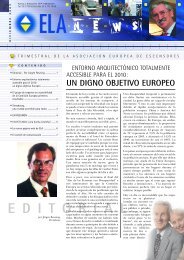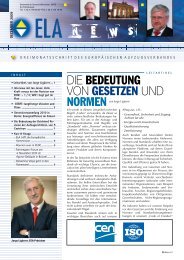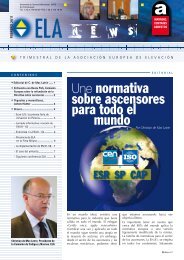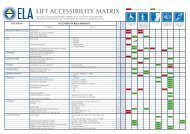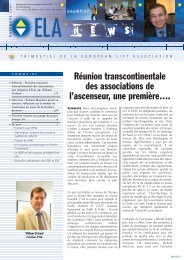WP6-Brochure-E4 brochure - ELA European Lift Association.
WP6-Brochure-E4 brochure - ELA European Lift Association.
WP6-Brochure-E4 brochure - ELA European Lift Association.
Create successful ePaper yourself
Turn your PDF publications into a flip-book with our unique Google optimized e-Paper software.
1 Introduction<br />
Means of vertical transportation, for both people and other loads, have been employed by<br />
mankind since ancient times.<br />
In early agricultural societies, these devices relied on men, animal or water power to lift the<br />
load. Rudimentary rope and pulley arrangements were used to support and move the required<br />
weight. Reference to this type of equipment can be found as far back as Ancient Greece.<br />
The Industrial Revolution brought with it a number of technological advancements. Machine<br />
power allowed for fast developments and safety systems were introduced. In 1880, the first<br />
electric motor was used to power a lift.<br />
Led by ever growing needs in the industry, with the necessity of moving great amounts of raw<br />
materials, and the introduction of steel beam construction and increasingly taller buildings, lift<br />
technology evolved rapidly.<br />
Energy efficiency has not been a major market and technological driver in this sector. Other<br />
design options like space restrictions, reliability and safety, riding comfort, etc. have been the<br />
central concerns of the vast majority of manufacturers. The last few years have witnessed a<br />
change of course with companies introducing energy efficient technologies for competitive<br />
reasons and, at the same time, to help their customers save energy and money.<br />
Taking into account demographic trends as well as a growing need for convenience, it is<br />
expected that the number of lifts and escalators will be rising worldwide, as well as in Europe.<br />
Further urbanisation in developing countries and a growing awareness of accessibility issues<br />
due to an aging population in Europe will foster the need for more of this equipment.<br />
There is already about 4,8 million lifts, as well as about 75 thousand escalators and moving<br />
walks installed in the EU‐27. Their energy consumption adds up to 3 to 5 % of the overall<br />
consumption of a building. About one third of the final energy consumption in the <strong>European</strong><br />
Community occurs in the tertiary and residential sector, mostly in buildings. Due to the<br />
increasing comfort requirements, energy consumption in buildings recently experienced a<br />
significant raise, being one of the leading reasons for a growing amount of CO2 emissions. High<br />
untapped saving potentials exist with respect to energy‐efficient equipment, investment<br />
decisions and behavioural approaches, in these sectors. The <strong>E4</strong>‐project is targeted at the<br />
improvement of the energy performance of lifts and escalators in tertiary sector buildings and<br />
in multi‐family residential buildings. As part of the project four major tasks were carried out.<br />
a) A survey was conducted with the collaboration of national lift and escalator<br />
manufacturers and installers associations. The purpose of the survey was to overcome<br />
the lack of information related to the lifts and escalators installed base. Detailed data<br />
was collected regarding the technical characteristics of the equipment used<br />
(technology used, load, speed, motor power), as well as other relevant parameters,<br />
such as age of the installations, type of building and number of trips per year. This<br />
information was later used to estimate the energy consumption of lifts and escalators.<br />
5





